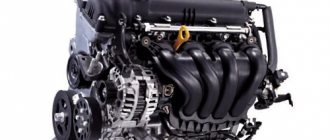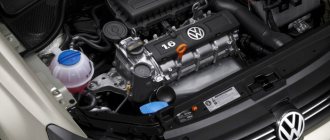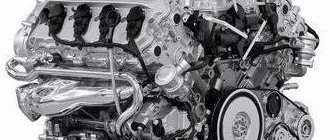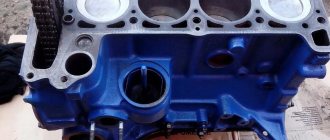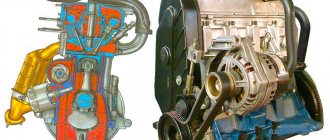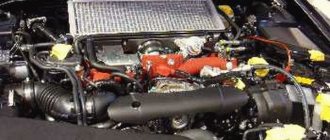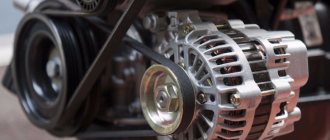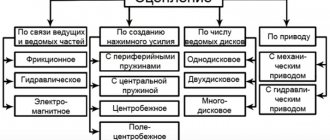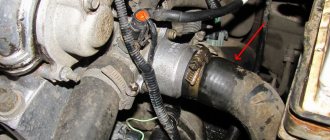The Geely MK car is equipped with a transversely mounted four-stroke four-cylinder petrol injection 16-valve engine with a displacement of 1.5 liters.
The engine is with in-line vertical cylinders, liquid cooling.
Camshaft
The exhaust valves are driven by the timing belt, the intake camshaft is driven by the exhaust camshaft using helical gears mounted on the camshafts.
Replacing the timing belt, see Replacing the exhaust camshaft oil seal, see Replacing the camshafts, see The cylinder head
is made of aluminum alloy according to a transverse cylinder purging pattern (intake and exhaust ports are located on opposite sides of the head). Valve seats and guides are pressed into the head. The intake and exhaust valves have one spring each, fixed through a plate with two crackers. A non-shrinkable metal-reinforced gasket is installed between the block and the head. In the upper part of the cylinder head there is a common bed of bearing supports for two camshafts (intake and exhaust). The upper bed covers of the bearing supports are attached to the block head with bolts that secure the bed covers to the base of the bed. The holes of the sliding bearing supports (bed) are processed together with the covers, so the covers are not interchangeable; each cover is marked with a serial number. Replacing valve stem seals, see Replacing the cylinder head gasket, see Replacing cylinder head cover gaskets, see Installing the piston of the first cylinder to the TDC position of the compression stroke, see Checking and adjusting the clearances in the valve drive, see
Cylinder block
The engine is a single cast iron casting that forms the cylinders, cooling jacket, lubrication system and five crankshaft bearings. At the bottom of the block there are five beds of main bearings. The cylinder block has special bosses, flanges and holes for fastening parts, assemblies and assemblies, as well as channels for the main oil line. Checking, adjusting and replacing drive belts, see
Crankshaft
rotates in main bearings having thin-walled steel liners with an anti-friction layer. The engine crankshaft is secured against axial movements by two half-rings installed in the grooves in the bed of the middle main journal bearing. Removing, troubleshooting and installing the crankshaft, see Replacing crankshaft oil seals, see
Flywheel
cast iron, mounted on the rear end of the crankshaft through a mounting sleeve and secured with six bolts. A toothed rim is pressed onto the flywheel to start the engine with a starter. The flywheel has a gear ring for the crankshaft position sensor. To replace the flywheel, see
Pistons
made of aluminum alloy. On the cylindrical surface of the piston head, annular grooves are made for one oil scraper ring and two compression rings. The pistons are additionally cooled by oil supplied through a hole in the upper end of the connecting rod and sprayed onto the piston crown. For defective parts of the connecting rod and piston group and cylinder block, see Replacement of parts of the connecting rod and piston group, see
Piston pins
installed in the piston bosses with a gap and pressed with an interference fit into the upper heads of the connecting rods, which with their lower heads are connected to the connecting rod journals of the crankshaft through thin-walled liners, the design of which is similar to the main ones.
Connecting rods
steel, forged, with an I-section rod.
Lubrication system
combined: the most loaded parts are lubricated under pressure, and the rest - either by directed splashing or by splashing oil flowing from the gaps between the mating parts. Replacing the oil sump seal, see Replacing the oil and oil filter, see Replacing the oil pump, see Replacing the interior heater valve, see
Crankcase ventilation system
The closed type does not communicate directly with the atmosphere, therefore, simultaneously with the suction of gases, a vacuum is formed in the crankcase under all engine operating modes, which increases the reliability of various engine seals and reduces the emission of toxic substances into the atmosphere.
Cooling system
The engine is sealed, with an expansion tank, consists of a cooling jacket made of casting and surrounding the cylinders in the block, combustion chambers and gas channels in the cylinder head. Forced circulation of coolant is provided by a centrifugal water pump driven from the crankshaft by a poly-V-belt, which simultaneously drives the generator pulley. To maintain the normal operating temperature of the coolant, a thermostat is installed in the cooling system, which closes a large circle of the system when the engine is not warmed up and the coolant temperature is low. Replacing the expansion tank see Replacing the water distribution box see Replacing the thermostat see Replacing the water pump see Replacing the electric radiator fan see Replacing the radiator see Replacing the coolant see
Supply system
The engine consists of an electric fuel pump installed in the fuel tank, a throttle assembly, coarse and fine fuel filters, fuel lines and injectors, and also includes an air filter. Replacement of thermal shields of the exhaust system, see Replacement of the main muffler, see Replacement of the additional muffler, see Replacement of the exhaust pipe, see Replacement of the exhaust manifold, see Replacement of suspension cushions of the exhaust system, see Replacement of the throttle drive pedal, see Replacement of the throttle drive cable, see Replacement idle speed control see Replacing the throttle assembly see Replacing the air filter housing see Replacing the air filter see Replacing the intake manifold gasket see Replacing the canister purge solenoid valve see Replacing the fuel vapor recovery system canister see Replacing the filler pipe see Replacing the fuel tank see Replacing and checking injectors see Replacing the fuel pressure regulator see Replacing the fuel rail see Replacing the fuel filter see Replacing the fuel pump see Checking and reducing pressure in the power system see
The design of the intake manifold with independent long channels allows the use of the effect of inertial charging.
Ignition system
microprocessor engine, consists of a four-terminal ignition coil (module), high voltage wires and spark plugs.
The ignition module is controlled by the electronic unit (controller) of the engine management system. The ignition system does not require maintenance or adjustment during operation.
Power unit
(engine, clutch and gearbox) is installed on three supports with elastic rubber elements: two side ones (right and left), which absorb the bulk of the power unit, and a rear one, which compensates for the torque from the transmission and the loads that arise when starting the car, acceleration and braking. Replacement of engine mudguards, see Replacement of engine mounts, see.
| MR479QA Specifications | |
| engine's type | 4-stroke, in-line 4-cylinder, 16-valve, water-cooled, dual counter-rotating camshafts |
| Combustion chamber type | Wedge-shaped |
| Inner diameter of the cylinder, mm | 78,7 |
| Piston stroke, mm | 77 |
| Cylinder volume, l | 1,498 |
| Compression ratio | 9,8 |
| Compression pressure (compression), kPa, not less | 980 |
| Permissible pressure difference in cylinders, kPa, no more | 100 |
| Oil volume, l | 3.0 |
| Fuel | Unleaded gasoline with an octane rating of at least 93 |
| Cylinder operating order | 1-3-4-2 |
| Shaft rotation direction (front view) | Clockwise |
| Lubrication system | Spray under pressure |
| Cooling system | Forced type |
| Thermostat valve opening temperature, °C | 82 |
| Full opening temperature of the thermostat valve, °C | 95 |
| Crankshaft rotation speed corresponding to maximum power, min-1 | 6000 |
| Maximum power, hp | 94 |
| Maximum torque at rpm, Nm | 128 |
| Crankshaft rotation speed corresponding to maximum torque, min-1 | 3400 |
| Idle speed, min-1 | 800±50 |
| Intake valve clearance on a cold engine, mm | 0,20±0,03 |
| Valve clearance of the exhaust valve on a cold engine, mm | 0,30±0,03 |
| Engine (front view): 1 — drive belt for generator and water pump; 2 — bracket for fastening the right suspension support of the power unit; 3 - generator; 4 — oil filler plug; 5 — throttle assembly; 6 - high voltage wire; 7 — cylinder head cover; 8 — intake manifold; 9 — cylinder head; 10 — inlet pipe of the engine cooling system; 11 — ignition module; 12 — water distribution box; 13 — crankshaft position sensor; 14 — left suspension support of the power unit; 15 — working cylinder of the hydraulic clutch release; 16 — control oxygen concentration sensor; 17 — exhaust manifold; 18 — oil filter; 19 — oil sump; 20 — air conditioning compressor; 21 — air conditioning compressor drive belt |
The information is valid for MK models from 2006 to 2020, and for MK Cross models from 2011 to 2020.
The engine is the heart of the car. It does not forgive low-quality spare parts, consumables and unqualified service. Therefore, every car enthusiast is primarily interested in the reliability and durability of the engine.
The engine of the Geely MK Cross is a variation of the Toyota 5A-FE
, purchased by the company under license. It was installed on the Toyota Corolla A100 - the standard of reliability and quality of the Japanese automobile industry. With timely maintenance, this unit could easily cover a million kilometers.
For the Chinese market, engines of 1.8 and 1.3 liters are installed. But only the version with a gasoline engine with a volume of 1498 cubic meters (94 hp) is supplied to Russia. It is this that will be discussed further.
Engine
The Geely MK engine has a timing belt drive. From experience, it doesn’t hurt to check the condition of the belt after 40-50 thousand km. Some do not show the slightest signs of wear after 60,000 km, while others may be missing a couple of teeth, and the belt turns out to be covered with cracks. Fortunately, when the valve belt breaks, the pistons and valves do not collide. When replacing the timing belt, the right engine mount must be removed.
During a cold start, the Geely MK engine often begins to “trouble.” The problem can be solved after replacing spark plugs, high-voltage wires, ignition coils (1,000 rubles) or adjusting the valves. When removing high-voltage wires, owners often tear them off. Neglecting valve adjustment is fraught with the risk of them “squeezing” with a mileage of more than 40-60 thousand km and subsequent burnout. Burnouts are more common on cars with installed gas equipment.
Over time, the gasket on the throttle heating begins to leak antifreeze. When the coolant dries out, it contaminates the idle air regulator channel and the regulator itself. The result is difficult starting, the engine stalls immediately after setting and starts only with the gas pedal depressed. To prevent leaks from occurring, after cleaning the channel, it is better to seal the throttle gasket with a heat-resistant sealant. A new original idle air control costs about 1,000 rubles; an analogue for a Chevrolet Niva for 500 rubles is suitable as a replacement.
The Geely MK engine is prone to overheating in the warm season during prolonged driving at speeds of more than 100 km/h with the air conditioning turned on. The problem appears when the mileage is more than 40-50 thousand km. One of the reasons is the cooling fan not working due to poor contact at one of the three ground wire attachment points. Overheating can also be caused by late opening of the thermostat and the peculiarity of the engine ECU, which gives the command to turn on the fan already at critical values of the coolant temperature. The coolant temperature sensor itself may produce incorrect values due to souring of the contact terminals. “Underheating” or a long warm-up of the engine indicates that the thermostat is souring in the open position, which is also not uncommon. A new thermostat costs about 200 rubles.
Some owners are faced with the need to replace a blown cylinder head gasket. The engine liquid cooling pump may fail after a mileage of more than 50-100 thousand km. The appearance of rust-colored spots in the expansion tank causes confusion. In cold weather, cooling radiators often leak at the junction of plastic and metal.
The exhaust system O-ring at the junction of the exhaust manifold with the pipe often has to be replaced due to burnout. With a mileage of more than 80-120 thousand km, the front crankshaft oil seal begins to leak. The oil pressure sensor may fail after a mileage of more than 50-60 thousand km.
The rear engine mount runs for more than 40-60 thousand km, after which it starts knocking. A new support will cost 1.5-2 thousand rubles.
After 150-200 thousand km, oil consumption often increases. It is not always possible to eliminate oil leaks simply by replacing the valve stem seals. Often stuck rings are also to blame. A set of rings and caps is available for 4,000 rubles.
Engine (ICE) Geely MK Cross
You can purchase a new or contract Geely MK Cross engine from us. An engine (ICE) for a Geely MK Cross is usually purchased if repairing the old engine is not possible. In addition, if, for example, only the nominal dimensions of the piston group are used for the engine, and the crankshaft will need to be sharpened, then the only option left is to purchase another engine. At our service stations, there is an option to buy a rebuilt engine after light or major repairs.
Engine options Geely MK Cross:
1. Used Geely MK Cross engine
- This is an engine that was removed from another car and presumably can work. As a rule, such engines are removed from damaged cars. Some have mileage data, some don't. The warranty for a used engine is from 5 to 30 days from the date of purchase. In fact, the warranty ends at the time of installation and testing of its functionality.
2. Rebuilt Geely MK Cross engine
- this is an engine that had problems that the client did not want to fix or the delivery time for spare parts was very long. The client leaves such an engine to the motor mechanic, who slowly purchases the necessary spare parts and repairs it. As a rule, in addition to new parts for the previous problem, all gaskets and seals on the engine are replaced. Rebuilt engines are usually sold without attachments. This is the rarest type and if it is available, it is better to immediately buy such an engine. The warranty on the rebuilt internal combustion engine is 3 months or 20,000 km. mileage
3. Contract engine Geely MK Cross
- this is an engine that is essentially used, but without mileage in Russia. Considering that car disposal abroad is very expensive, the owners sell such cars entirely, and we buy removed components and assemblies. Depending on the region of assembly, we import engines from different countries in Europe, Asia and the USA. Lately, we have been importing a lot of engines from the UAE.
4. New Geely MK Cross engine
— supplied directly from the manufacturer's factory. In rare cases, we have them in stock, but these are either engines for reserves or for corporate clients. Sold without attachments. The optimal purchase option is to buy it, install it and go.
Engine price (ICE) Geely MK Cross:
| Options | ICE price | Buy |
| Used Geely MK Cross engine | from 12,000 rub. | |
| Rebuilt Geely MK Cross engine | from 14500 rub. | |
| Contract engine Geely MK Cross | from 20,000 rub. |
Do you want to buy a Gili MK Cross engine? Call or write to us right now!
from 20.00 to 10.00
send us a request to:
Whatsapp/Viber
The cost of the engine depends on whether it is new, used, rebuilt or new, as well as on the availability of attachments, availability in our warehouse or delivery time to our store. Also, the cost is determined depending on the condition of the engine. There are used engines with a broken block, which a person buys only to take only the cylinder head from it.
Important information for purchasing an engine:
— we do not pay for the costs of removing/installing the engine if it does not work or does not work correctly; — we can re-remove and install an engine purchased from us, only at our service station; — to maintain the warranty on the engine, it must be installed at a service station that has the appropriate certificate; — before purchasing, check whether the engine comes with or without attachments; — the engine is not a numbered unit and data about it is not entered into the PTS and STS; — re-registration of the engine is only necessary if you bought and installed another engine, different in power and volume.
Transmission
The 5-speed manual transmission on the new Geely MK suffers from poor gear shifting for the first few thousand kilometers. Afterwards, the elements of the box “roll in”, and there are no problems with the ease of shifting gears. A significant contribution to poor speed selectivity is made by “cheap” oil poured into the box during assembly. This “transmission” thickens greatly in the cold. After changing the working fluid, the performance of the box improves.
With a mileage of more than 50-70 thousand km, the box begins to make noise. The reason is wear of the bearings of the primary and secondary shaft. It is noteworthy that in the warranty book the box bearings are listed as a separate item, and the warranty for them is only 30 thousand km. For the work of removing and installing the box you will have to pay about 3 thousand rubles, for the bulkhead - about another 4 thousand rubles, a set of new bearings will cost 1-2 thousand rubles.
The clutch lasts for more than 90-120 thousand km. A new set with a basket and release bearing will cost 3-5 thousand rubles. With a mileage of more than 100,000 km, the gearbox often begins to make noise when releasing the gas in third gear.
Drive seals can leak after 30-40 thousand km. The cost of the drive oil seal is about 500 rubles. After 50-60 thousand km, it may be necessary to replace the clutch master cylinder. A leaking cylinder can be restored using a repair kit for 600 rubles.
The boots of the outer CV joint will most likely have to be replaced when the mileage exceeds 100-120 thousand km. It will not be possible to find original anthers separately, since they are sold only complete with the drive. But finding an analogue in a spare parts store for other car brands will not be difficult.
Chassis
The Geely MK suspension is not particularly durable. The front stabilizer struts are the first to go - after 20-30 thousand km. Stabilizer bushings last a little longer - about 40-60 thousand km. Shock absorbers may leak or knock after 30-60 thousand km. The cost of a new one is in the range of 1.5-2.5 thousand rubles. Front wheel bearings last more than 60-80 thousand km. The ball and suspension arms travel the same amount. A new ball costs about 800 rubles.
Due to the “crooked” assembly, the steering rack has lateral play, which can be removed after tightening. Often the rack begins to leak after 50-100 thousand km. The cost of a new rail is about 15-20 thousand rubles. Steering rods and ends last more than 50-80 thousand km. Sometimes the power steering pump also fails.
Due to corrosion of the piston coating of the front caliper brake cylinder, the brakes may jam when the mileage is more than 50-70 thousand km. The repair kit will cost 400 rubles. Sometimes the rear brake cylinders begin to “poison” the brake fluid.
Transmission
Only a 5-speed manual worked in conjunction with the engine. Clutch life is over 60-100 thousand km. To replace it, the box has to be removed. The cost of a new clutch kit is 4-5 thousand rubles, and the cost of work is 3-6 thousand rubles.
Unfortunately, the manual transmission may require repair after 50-100 thousand km. There is noise, hum, or gears are difficult to engage. As a rule, only the bearings have to be changed (about 10,000 rubles). If the bearings fall apart, the gears will be destroyed, and the housing may also break. In this case, you will have to look for a used box (10-30 thousand rubles). A new manual transmission costs more than 40,000 rubles.
Read more: Lada vesta sw cross latest news
Sometimes it is possible to get rid of the noise by tightening the secondary shaft bearing. This is done through a special hatch located on the box body on the left wheel side.
Body and interior
The body of the Geely MK does not resist corrosion well. The first lesions inevitably appear on chips. And after 1-2 years of operation, in the lower corner of the front doors under the seal, in the area of the trunk lid lock, gas tank flap and on the inner surface of the hood. Later, the wheel arches and sills begin to rot. Cars with a factory sunroof are most susceptible to sill corrosion. Engineers brought the hatch drains directly into the thresholds. You will have to pay over 30 thousand rubles to repair the thresholds.
Headlights and taillights often fog up, and foglight lenses often break when used in cool, damp weather.
The hard plastic interior of the Geely MK is very creaky, especially in cold weather. A rattling sound in the steering wheel may occur due to the screws holding the airbag unit loosening over time. A loose steering shaft seal allows noise from the engine and exhaust system into the cabin.
One of the problems of the Geely MK is water in the cabin. It gets there due to poorly taped windshield and rear windows, as well as through flying rubber plugs on the bottom. Water accumulates in the trunk due to the rear light seats and rear shock absorber mounts. Water can also enter through ventilation valves.
The operation of the climate control system also causes a lot of criticism. The air conditioner becomes ineffective when the ambient temperature exceeds 25-30 degrees Celsius. This is facilitated by the design feature of the heating system: hot tubes and the heater radiator are located directly under the panel. Even in cool weather with the air conditioner and temperature controller turned off, warm air flows from the deflectors in the cold sector.
With a mileage of more than 100,000 km, leaks in the air conditioning system are detected more and more often. The air conditioning compressor (about 9-12 thousand rubles) may jam after 50-100 thousand km. The heater fan sometimes stops turning on or changing rotation speed due to the failure of the relay (rheostat) of the fan speed controller. The new regulator is not expensive - about 400 rubles.
Club Geely and Maple
In short, I am for this car!! Hi all!
At our first maintenance, they change the oil in the gearbox and engine, and that’s it! I personally stood watching! The air conditioner fuse keeps blowing at the dealership and they can’t tell me this is the only problem for all eleven thousand so far. Good day! Does anyone have problems with the Shumka after 10 thousand, the engine began to run noisier or is it just me?
GEELY Car Owners Club
And gasoline consumption exceeds all conceivable and inconceivable limits! We bought the Geely Mk Cross at the end of July and the mileage is km.
I run it on 95 Belarusian gasoline and gas, everything is fine. All gears are turned on, the doors are all closed, nothing leaks anywhere, the air conditioner cools, the stove heats. Recently I took 2 bags of feed to my mother-in-law in the trunk.
I thought they wouldn’t fit in, but they did. 30 years of experience driving trucks and cars and climbing under. Alexey from Ukraine, write about the car’s operation on gas during run-in. They recommend that I bet after 10 thousand.
Electrical equipment
Problems with charging current may appear after 80-120 thousand km. The reason is a failure of the voltage regulator. A set of a new relay and brushes will cost 2.5-3.5 thousand rubles. A new generator costs about 4.5-5.5 thousand rubles.
Due to the short circuit of the temperature sensor of the seat heating element or the “sticking” of the heating button, the heated front seats may stop working. Factory heating elements for heating mirrors do an excellent job, but they often fail. After replacing the mirrors with an analogue one, the heating becomes less effective, but much more durable.
With a mileage of more than 100-150 thousand km, a break in the steering column wiring harness is possible. There are also frequent problems with the dashboard lighting. The reason is the failure of the driver board microcircuit for the electric motors that control the movement of the arrows and the lighting of the devices. The cost of a new tidy is about 7-8 thousand rubles.
Other problems and malfunctions
Unfortunately, the body metal of the MK Cross has poor corrosion resistance. The first rust begins to appear from under the plastic door sills after 3-4 years. Soon, rust spots are found on the hood, doors, roof, rear wheel arches and under the headlights on the fenders.
Electrically heated mirrors often fail (200-500 rubles per mirror element). There are also problems with the electronic instrument panel - the indication disappears. The device comes to life after soldering the board.
The generator can also get sick: the voltage regulator fails, or the brushes wear out.
There are difficulties with the stove motor (3,000 rubles) or its rheostat (900 rubles).
The heater radiator may leak or become clogged with sludge after 50-100 thousand km. The Toyota analogue is available for 2,000 rubles. The replacement process is labor-intensive. To access the radiator, you need to disassemble the front panel. For work in the service they will ask about 5,000 rubles.
From time to time, the cables for adjusting the air flow and the heater valve come off.
Features of operation
Fuel consumption
Unfortunately, it is almost impossible to meet the requirements under real operating conditions. And, if after running on the highway you manage to get closer to the desired result, then in the city the average consumption per hundred kilometers will be 9-10 liters
, with a very leisurely ride and without sudden acceleration. Otherwise, you can add a couple more liters on top.
Oil
Engine oil is changed as standard, once every ten thousand kilometers or once every twelve months. Both the factory and car owners recommend pouring synthetic, with a viscosity index of 5w40
.
As a rule, services are filled with Shell or Castrol
.
timing belt
The gas distribution mechanism is equipped with a belt drive. Changes at 60 thousand mileage
, but
it is better to check the condition after 40,000 km
. Replacement may be required earlier, but it happens that even after 60 thousand the belt is almost not worn out.
When the timing belt teeth slip or break, the valve
, as a rule,
does not bend
. Although no one is immune from exceptions. Therefore, it is better not to start the condition of the timing belt. The valves require adjustment every 40 thousand km.
What did we get?
The engine turned out to be more capricious than its predecessor from Toyota. More often it requires adjustment and can present unpleasant surprises. But, in general, the unit is reliable and easy to maintain. We can talk about a resource of 150-200 thousand before rebuilding the engine. And then the same amount until the overhaul. Which is quite a good result in the conditions of modern “disposable” cars.
The creation of budget power units attracts attention not only with their low price and modest fuel consumption. The modern buyer has become much more demanding and takes into account all the characteristics of the engine. The MR479QA motor is one of the best developments from the Geely concern. The company's products occupy a huge share of the Chinese market and are known beyond its borders. The engine characteristics provide the car with good driving dynamics, and the availability of spare parts will make any major repair possible.
Description and performance indicators of the MR479QA motor
Advancement in the automotive market is impossible without the development of modern engines. With the release of the MR479QA power plant, Geely showed the seriousness of its intentions to expand sales to the markets of Europe and Asia. Carefully calculated power ratings and maintainability have made engines made in China quite reliable for long-term operation. This engine uses BOSCH electronic control and a lot of technical solutions from Toyota.
The parameters of the MR479QA engine allow you to experience all the benefits of high-tech production. The power plant has much in common with the 5A-FE engine used in the Toyota Corolla, but the Geely MR479QA cannot be called a full replica of the Japanese engine. Most of its features have been changed to avoid lawsuits, but the internals and attachments are virtually identical. Among the features of the MR479QA are its low cost and low noise level in operation.
MR479QA Engine Specifications
All indicators of the power plant are precisely calculated and allow you to feel confident when driving the car. The engine design is a four-cylinder in-line design with a fuel injection system. The vertical cylinder arrangement and DOHC gas distribution system complement the engine's characteristics. This technology allows the use of 2 camshafts to service the cylinder head. The crankshaft in the MR479QA engine is mounted on reinforced main bearings and has rigid fixation to prevent axial vibrations.
The MR479QA engine has valve adjustments that must be performed regularly to prevent more serious damage. The cylinder head itself is made of aluminum alloy, and the intake and exhaust ports are on opposite sides. The remaining technical characteristics also deserve a little attention.
- The cooling system is closed and has no direct communication with the external environment. To prevent pressure drops, an expansion tank is used. The pump is equipped with a drive coming from the crankshaft, which ensures the circulation of coolant;
- Lubrication system - combined design guarantees a stable supply of oil under pressure for all components operating under load. Oil is supplied to the remaining elements by gravity or splashing;
- Flywheel - has a crimped toothed rim, which serves to start the engine with a starter. The flywheel itself is made of cast iron;
- Ignition is built on microprocessor control, ensuring high accuracy. The ignition module does not require adjustment, and spark plugs for the MR479QA engine can be used of iridium or conventional type.
The timing system is typical for an internal combustion engine of this design and uses a belt drive. Despite the similarity with the 4A-FE engine, spare parts from Toyota are not suitable for all, and you should carefully study the service manual or buy original parts.
Geely MR479QA engine maintenance
To create optimal conditions for engine operation, all recommendations of the manufacturer should be followed. Such information can be found in the user manual, indicating the timing and required maintenance procedures. With significant mileage, you should pay closer attention to the car, and a simple replacement of the valve stem seals can protect the cylinder head from major repairs. Items such as the air filter or fuel system also require maintenance that should not be forgotten.
For any car, changing the oil is of great importance. The driver should definitely know what kind of oil can be poured into the engine. In this regard, Geely is quite universal and the oil for MR479QA is 10w40 and 10W30. In winter, it is also possible to use 5w30. The engine manufacturer recommends replacing it after 10 thousand km, but the real need may arise after 5-7 thousand km. Oil control can be easily done using a dipstick, which will show its level and degree of production.
Removal and installation of the Geely MK / MK Cross engine
Remove the engine and gearbox assembly by lowering it down from the engine compartment. To do this, you need a lift to raise the front of the car higher. In garage conditions, if there is no lift, you will need a jack, as well as strong and high enough supports to install the raised front part of the car on them, which will allow you to remove the power unit from under the car, lowered to the garage floor.
1. Reduce the pressure in the power system (see here). 2. Disconnect the wires from the battery. 3. Remove the air filter housing (see here).
4. Remove the tips from the spark plugs.
5. Remove the high voltage wire tips from the ignition module sockets and remove them.
6. Remove the intake manifold (see here).
7. Remove the exhaust manifold (see here). 8. Remove the accessory drive belts (see here).
9. Remove the power steering pump (see here).
10. Without disconnecting the air conditioning system pipelines, disconnect the air conditioning compressor from the cylinder block and secure it, for example, with a wire in the engine compartment.
11. Remove the generator. (see here).
12. Using a screwdriver, pry the wire harness holder retainer...
13. ...and move the wiring harness to the side.
14. Remove the engine mudguards (see here).
15. Remove the exhaust pipe (see here).
16. Drain the engine cooling system. 17. Drain the engine oil if the engine is being removed for repair. 18. Drain the oil from the gearbox (see here). 19. Remove the front wheel drives (see here). 20. Disconnect the control cables from the gearbox and move them to the side (see here).
21. Remove the mounting bolt...
22. ...and disconnect the ground wire from the gearbox.
23. Unscrew the two bolts securing the working cylinder of the hydraulic clutch release and move the working cylinder with the pipeline to the side. Secure it to the body, for example, with wire. 24. Disconnect the wiring harness blocks and their holders from the engine control system sensors (see here).
25. Disconnect the engine cooling system hoses from the corresponding pipes located on the cylinder head.
26. Unscrew the protective cap towards the fastening nut
27. ...and disconnect the tip of the power wire from the starter traction relay.
28. Squeeze the latch.
29. ...and disconnect the wire block from the starter traction relay.
30. Squeeze the latch.
31. Disconnect the wiring harness connector from the speed sensor.
32. Remove the front suspension cross member (see here). 33. Attach the lifting mechanism slings to the transport hooks and tighten the slings. 34. Remove the power unit suspension mounts (see here). 35. Check again that all wires, hoses and attachments are disconnected from the power unit. 36. Raise the front part of the car (raise the car on a lift) to a height sufficient to remove the power unit from under the car, and place reliable supports under the body. 37. Lower, remove the slings and remove the power unit from under the vehicle. 38. If necessary, remove the gearbox (see here) and clutch (see here). 39. Install the engine and all removed parts and assemblies in the reverse order of removal, taking into account the following: before installing the power unit, use a tap to remove rust from the threaded holes securing its supports; • be sure to replace the collector gasket with a new one; • when connecting wires and pipelines, carefully ensure that they are correctly positioned in the engine compartment, avoiding contact with the heating elements of the power unit.
After installing the engine, perform the following operations: 40. Fill with coolant. 41. Fill the gearbox with oil. 42. Fill the engine with oil.
43. Check the tension of the accessory drive belts. 44. Start the engine and check for fuel, oil and coolant leaks. Check oil pressure. Listen to the engine, it should run smoothly, without any extraneous noise or knocking.
The information is valid for MK models from 2006 to 2020, and for MK Cross models from 2011 to 2020.
Malfunctions of MR479QA series motors
There are shortcomings in the operation of every engine, and Geely power units are no exception. The largest number of malfunctions is caused by rapid wear and tear of the vehicle's chassis and engine. Its resource is much less than that of European-made cars, although absolutely all companies are not too interested in cars with a million-dollar resource. The advantage of the MR479QA is that even if the belt breaks, the valve does not bend, and the car itself can be restored after almost any breakdown.
Each engine has a rather complex design and you should not interfere with the operation of the motor with your own hands. Geely can replace almost any attachment, which allows you to restore the engine in case of a wide variety of faults.
Do the valves bend when the Geely MK timing belt breaks?
We replace the stove radiator on a Daewoo Nexia with our own hands. The simple heating system of the Daewoo Nexia is good because it is simple in maintenance and repair, debts. If the belt breaks, the operation is not particularly difficult; it is quite feasible for owners who confidently hold wrenches in their hands and know the structure of their car. If this is not possible, the replacement can be done on level ground, but you will need a car jack. The video channel was recently opened.
Geely CK 2007 - breakdown
Subscribe so you don't miss anything interesting. At the end of the replacement and complete assembly, start the engine and check that all systems are working properly. It takes hours, but you can save a decent amount and gain valuable experience in car repair. Everything is step by step. The proper operation of any car largely depends on the condition of the components, which must be regularly changed after a technical inspection.
We recommend: How to check the oil level in a gearbox on a Geely MK
The article describes replacing the timing belt on a Geely MK with your own hands, and also attaches a video in which you can visually see the whole process. Detailed instructions and videos will help even a novice driver perform the operation, giving him the opportunity to save on visiting a car service center. A Chinese-made car arrived to replace the timing belt.
Engine tuning options
Upgrading the engine on Geely cars allows you to increase power and torque. For such tuning, electronic control optimization is usually used. Boosting a Chinese car by making physical changes to the operation of the internal combustion engine is not always advisable. Such intervention can lead to rapid wear of engine parts and the money spent will not yield results.
For the MR479QA engine, a tuning chip is sufficient, which guarantees a minimum increase in power within 10%. Carrying out such an operation does not take much time and does not require partial disassembly of the machine. Correct tuning does not lead to an increase in fuel consumption, which will be important for any car owner. The decision to carry out such modernization should be based on the need for increased power.
Vehicles with MR479QA engine
Geely produces a fairly large range of cars that are used in various countries. The release of the MR479QA engine made it possible to update the line of 1.5 liter engines with modern models of power plants. The characteristics of such an engine are well balanced for city driving and will allow you to feel the pleasure of driving on the highway. The installation of such a motor has been carried out since 2003 and does not stop today.
The Geely MR479QA engine, although it does not have a long service life, turned out to be quite successful. Models BL, CK, MR and MK can boast of such a power plant. The Chinese company installs engines with different displacements, but with a similar internal combustion engine design, into its cars. Although the MR479QA powertrain does not have huge power, its potential is enough for a budget car.
Characteristics of the MR479QA power plant
An economical engine with good driving performance will be convenient for various purposes. More complete characteristics are noted in the table and everyone can independently evaluate the Geely engine.
| Production | Geely |
| Engine make | MR479QA |
| Years of manufacture | 2003 — … |
| Cylinder block material | cast iron |
| Supply system | injector |
| Cylinder head | DOHC |
| Number of cylinders | 4 |
| Valves per cylinder | 4 |
| Piston stroke, mm | 77 |
| Cylinder diameter, mm | 78,7 |
| Compression ratio | 9,8 |
| Engine capacity, cc | 1498 |
| Engine power, hp/rpm | 94/6000 |
| Torque, Nm/rpm | 128/3400 |
| Fuel | gasoline A 92 |
| Environmental standards | Euro II |
| Engine weight, kg | n.d. |
| Fuel consumption, l/100 km | 4.7 — 6.3 |
| Cooling system | forced |
| Engine oil | 10w40 |
| 10W30 | |
| 5w30 | |
| How much oil is in the engine, l | 3 |
| Cylinder operating order | 1-3-4-2 |
| Turbine | No |
| Oil change carried out, km | 1500 is better than 7500 |
| Oil consumption, ml/100km | up to 300 |
| Engine life, thousand km | |
| - according to the plant | n.d. |
| - on practice | 100+ |
| Tuning | |
| — potential | + |
| - without loss of resource | n.d. |
| The engine was installed | GEELY BL |
| GEELY CK | |
| GEELY MR | |
| GEELY MK |
The power unit has a lot of positive characteristics that indicate its reliability. Stable compression performance and well-chosen volume will ensure the practicality of such an engine. Good driving dynamics and reliability of the fuel system make choosing a car with this engine quite acceptable. Although its operation is not designed to last for several decades of intensive work, it will be sufficient for the needs of most drivers.
Which battery to choose?
In the table below we provide a list of batteries that meet all the technical characteristics required for batteries for the Geely MK and Geely MK Cross. The most popular cars with a good price/quality ratio are:
| Appearance | Name | Voltage | Starting current | Capacity | Polarity | Standard size | Where can I buy |
| HANKOOK 55B24RS | 12 V | 430 A | 45 Ah | straight | 238x129x227 | Ya.Market | |
| FB SUPER NOVA 55B24R | 12 V | 440 A | 45 Ah | straight | 238x129x225 | Ya.Market | |
| BANNER POWER BULL (P45 24) 45L 390A | 12 V | 390 A | 45 Ah | straight | 236x126x227 | Ya.Market | |
| DELKOR 70B24R | 12 V | 480 A | 55 Ah | straight | 238x129x227 | Ya.Market | |
| CENE 65B24R | 12 V | 490 A | 55 Ah | straight | 238x129x227 | Ya.Market |
